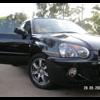What car 2 buy?
Announcements
-
Similar Content
-
Latest Posts
-
That's a short. Find the short. It will be somewhere between that fuse and the headlight. Start by removing the plugs from the back of the headlight and dimmer switches, and measure resistance to earth. Supply side (power from the fuse) should have none. The other side should have resistance compatible with whatever globe(s) is there (which is relatively easy to say for a normal globe, perhaps not as easy to say for LEDs). Anyway, if you have very low resistance, you defo have a short. Then you just have to run the wiring like you're running the bowel of a dog (on the operating table) that has swallowed something it wasn't supposed to.
-
Hey guys, need help figuring out why my driver side (RH) fuse 15amp keeps blowing. The Driver Sides Headlamp is out, i replaced these a long time ago with LED ones that were working for 1-2 years. Now, the driver side light is out and i traced it back to a broken fuse. I replaced the 15 amp fuse in the engine bay and as soon as i flip the headlight on, it blows the new fuse. Any idea what's going on?
-
By Watermouse · Posted
I found the same with Subaru’s. I own and love the SG9 Forester, after that model 2008+, Subaru threw the ugly stick at all their line up and somehow managed to make them look worse with every succeeding year. lol -
It's something we all have to consider as time marches on. Also consider lifted rally MX5 conversion at that point.
-
I should be fine for a few more years, whilst I do have arthritis I also exercise and do mobility training every day to keep as fit and healthy as I can, military life, which is the actual cause of most of my joint issues, has set daily regimes, which I weirdly enjoy I also train alot smarter now, not really focusing on lots strength or puffy muscles, I'm more focused on maintaining what I have for my future older self, I actually train as much mobility now as I do exercising Check out this "simple" drill I have been doing daily prior to training now for a while now, this has worked wonders in my all round mobility
-






Recommended Posts